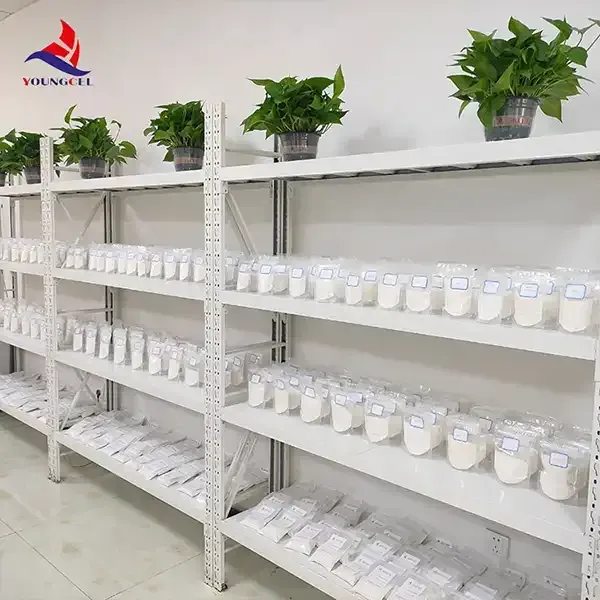HEC Cellulose An Overview of Hydroxyethyl Cellulose and Its Applications
Hydroxyethyl cellulose (HEC) is a non-ionic, water-soluble polymer derived from cellulose, a natural polymer found in the cell walls of plants. As one of the most widely used cellulose derivatives, HEC possesses unique properties that make it suitable for various applications across multiple industries. This article explores the characteristics of HEC, its production process, and its diverse applications, particularly in the fields of construction, pharmaceuticals, and personal care.
Production Process
The production of HEC involves the etherification of natural cellulose, which is typically sourced from wood or cotton. The cellulose is first treated with an alkaline solution to create a reactive form, which is then subjected to hydroxyethylation using ethylene oxide. The degree of substitution, which indicates how many hydroxyl groups have been replaced with ethylene oxide, determines the solubility and viscosity of HEC in water. This tailored production process allows manufacturers to create HEC with specific properties to meet the needs of various applications.
Properties of HEC
HEC is valued for its unique physical and chemical properties. It is characterized by its excellent solvent stability, forming clear, viscous solutions in water. This property makes it an effective thickening agent and emulsifier, enhancing the texture and stability of formulations. HEC is resistant to temperature changes and can maintain its consistency across a wide range of pH levels. Furthermore, it exhibits good film-forming abilities, making it an ideal additive for products that require a smooth finish and protective layer.
Applications in Construction
hec cellulose

The construction industry extensively utilizes HEC as a key ingredient in various building materials. It is commonly found in cement-based formulations, tile adhesives, and self-leveling compounds. HEC enhances the workability of these materials, allowing for better adhesion and smoother application. Its water-retaining properties prevent rapid drying, ensuring that construction materials achieve optimal strength and durability. As a result, the incorporation of HEC in construction products leads to improved performance, reduced wastage, and increased efficiency on-site.
Pharmaceutical and Personal Care Applications
In the pharmaceutical sector, HEC serves as a thickening and binding agent in various formulations, including gels, creams, and ointments. Its ability to create stable, viscous products enhances the delivery of active ingredients, ensuring that medications are effective and user-friendly. Additionally, HEC is utilized in ophthalmic solutions because of its compatibility with biological systems and ability to provide a lubricating effect, making it beneficial for dry eye treatments.
Furthermore, in the personal care industry, HEC is found in numerous cosmetics and skincare products. Its thickening properties contribute to the desirable texture of lotions, shampoos, and conditioners. HEC also acts as a stabilizer in emulsions, ensuring the uniform distribution of oil and water phases. The non-irritating nature of HEC makes it suitable for sensitive skin formulations, where gentle ingredients are paramount.
Conclusion
Hydroxyethyl cellulose stands out as a versatile polymer with a wide array of applications across various industries. Its unique properties, such as solubility, stability, and film-forming abilities, make it an essential ingredient in construction materials, pharmaceuticals, and personal care products. As industries continue to seek sustainable and effective solutions, HEC offers a promising option derived from renewable resources. Its role in enhancing product performance while maintaining safety and compatibility positions HEC as a valuable component in modern formulations. As research progresses and innovation unfolds, the potential applications of HEC may continue to expand, further demonstrating the versatility of this remarkable cellulose derivative.
-
Rdp Powder: Key Considerations for Wholesalers in the Building Materials IndustryNewsJul.08,2025
-
Key Considerations for Wholesalers: Navigating the World of Hpmc - Based ProductsNewsJul.08,2025
-
Hpmc Detergent: Key Considerations for WholesalersNewsJul.08,2025
-
Key Considerations for Wholesalers: China Hpmc For Tile Adhesive, Coating Additives, Concrete Additives, and MoreNewsJul.08,2025
-
Crucial Considerations for Wholesalers: Navigating the World of Construction MaterialsNewsJul.08,2025
-
Key Considerations for Wholesalers Sourcing Additive For Cement, Additive For Concrete, Additive For Putty from Additive Manufacturer Shijiazhuang Gaocheng District Yongfeng Cellulose Co., Ltd.NewsJul.08,2025




